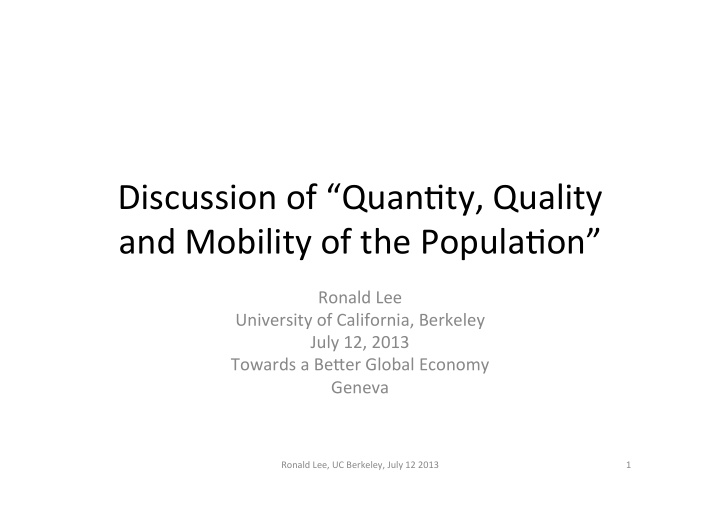



Discussion ¡of ¡“Quan-ty, ¡Quality ¡ and ¡Mobility ¡of ¡the ¡Popula-on” ¡ Ronald ¡Lee ¡ University ¡of ¡California, ¡Berkeley ¡ July ¡12, ¡2013 ¡ Towards ¡a ¡BeIer ¡Global ¡Economy ¡ Geneva ¡ Ronald ¡Lee, ¡UC ¡Berkeley, ¡July ¡12 ¡2013 ¡ 1 ¡
Chapter ¡Review ¡ • Terrific ¡job ¡of ¡surveying ¡an ¡enormous ¡literature ¡across ¡many ¡topics ¡ and ¡drawing ¡lessons ¡and ¡policy ¡recommenda-ons ¡from ¡it. ¡E.g. ¡ – Importance ¡of ¡global ¡trends ¡in ¡educa-on ¡ ¡ – Non-‑formal ¡kinds ¡of ¡educa-on ¡may ¡be ¡more ¡important ¡than ¡formal ¡ – Importance ¡of ¡health ¡and ¡nutri-on ¡inputs ¡for ¡Human ¡Capital ¡in ¡ developing ¡countries ¡ – Role ¡of ¡urbaniza-on ¡in ¡economic ¡development ¡ – Poten-ally ¡enormous ¡welfare ¡gains ¡through ¡interna-onal ¡migra-on ¡ • Here ¡I ¡will ¡touch ¡on ¡some ¡topics ¡drawing ¡on ¡Na-onal ¡Transfer ¡ Accounts ¡data. ¡ Ronald ¡Lee, ¡UC ¡Berkeley, ¡July ¡12 ¡2013 ¡ 2 ¡
Demographic ¡transi-on ¡is ¡a ¡useful ¡framework ¡for ¡this ¡ study. ¡Illustrate ¡with ¡China ¡Support ¡Ra-o ¡ China Support Ratio 2012 to 2050, population 1 aging subtracts .4% per 1974 to 2012, adds year from growth per .8% per year to 0.95 consumer. growth per consumer 0.9 Dividend ¡ Pop ¡Aging ¡ Support Ratio phase ¡ phase ¡ 0.85 0.8 Contrast between the two is 0.75 -1.2% per year. 0.7 E. ¡Asia ¡ S. ¡Asia ¡ Europe ¡ Africa ¡ 0.65 La3n ¡Am ¡ 0.6 1940 1960 1980 2000 2020 2040 2060 Date Ronald ¡Lee, ¡UC ¡Berkeley, ¡July ¡12 ¡2013 ¡ 3 ¡
Public ¡+ ¡Private ¡Investment ¡in ¡kids’ ¡human ¡capital ¡ (rela-ve ¡to ¡labor ¡income) ¡and ¡declining ¡fer-lity ¡ Total ¡spending ¡is ¡ ¡5 ¡or ¡6 ¡years ¡of ¡labor ¡ income ¡on ¡total ¡HK ¡regardless ¡of ¡fer-lity. ¡ Ronald ¡Lee, ¡UC ¡Berkeley, ¡July ¡12 ¡2013 ¡ 4 ¡
Per capita net public transfers per child and per elder: 20 economies around 2000 (dashed lines are medians). Europe/Japan ¡ FI high ¡for ¡kids ¡ 30 (percent per capita labor income age 30–49) US/Twn: ¡ Per capita net public transfers to children HU High ¡for ¡elderly ¡ High ¡for ¡kids ¡ JP Low ¡for ¡elderly ¡ SI US SE 20 DE TW ES AT TH KR MX CL 10 CR ID UY BR PH La-n ¡Am: ¡ ¡ CN Asia: ¡ low ¡for ¡kids ¡ ¡ Low ¡for ¡both ¡ high ¡for ¡elderly ¡ 0 -10 0 10 20 30 40 50 60 70 80 90 100 Per capita net public transfers to the elderly (percent per capita labor income age 30–49) Source: ¡Tim ¡Miller, ¡Ch. ¡7, ¡Lee ¡and ¡Mason, ¡2011 ¡ Ronald ¡Lee, ¡UC ¡Berkeley, ¡July ¡12 ¡2013 ¡ 5 ¡
Natural ¡tendency ¡for ¡HK ¡investment ¡to ¡rise ¡ as ¡fer-lity ¡falls. ¡What ¡role ¡for ¡policy? ¡ • Public ¡educa-on ¡is ¡more ¡egalitarian. ¡ • Strong ¡public ¡educa-on ¡may ¡reduce ¡the ¡ intergenera-onal ¡transmission ¡of ¡ socioeconomic ¡status. ¡ • Strong ¡externali-es ¡to ¡educa-on ¡also ¡argue ¡ for ¡large ¡public ¡role. ¡ • Maintain ¡public ¡spending ¡as ¡share ¡of ¡GDP ¡as ¡ fer-lity ¡declines. ¡ Ronald ¡Lee, ¡UC ¡Berkeley, ¡July ¡12 ¡2013 ¡ 6 ¡
Recommend
More recommend